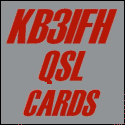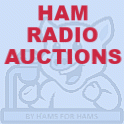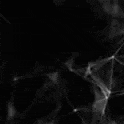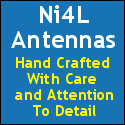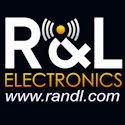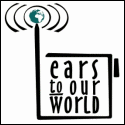Author Archive
 Catching Up With QSLs
Catching Up With QSLs
It’s been sometime since I have posted some of my incoming QSLs as I've been waiting arrival of the last one of my 6m winter DX season cards to arrive, which it finally did yesterday!
Unfortunately the peak of Solar Cycle 25 arrived a little ahead of time, peaking in the early fall rather than later or in early winter which is much more favorable for higher F2 MUFs. Nevertheless, some interesting days were to be had if the propagation patterns were followed closely, particularly after a solar event. Hopefully we will see a second peak of the cycle later this fall as most cycles have a double peak … if it comes in this summer, it’s not going to be of much help for 6m fans.
I started the 2024 6m sporadic-E season with a confirmed DXCC total of 110 countries and hoped to add at least one or two new ones via chordal-hop E or via F2 in the fall. My hopes were indeed met but if the cycle had peaked a few weeks later, the fireworks would have been something much more exciting.
 |
| JOHR 1287 kHz on Japan's northern Hokkaido Island |
 |
| Akashvani (ex-All India Radio) 15050 kHz |
 |
| Akashvani continues to be a reliable QSLer |
 |
| NTSC, China's 'WWV', can often be heard with its CW ident around dawn on 5.000 MHz. |
 Finding Your Best Crystal Radio ‘DX Diode’ (Part 2)
Finding Your Best Crystal Radio ‘DX Diode’ (Part 2)
Readers may recall my summertime blog, "Finding Your Best Crystal Radio ‘DX Diode'". It described a theoretical method I tried in order to see which of several dozen diodes might emerge as the best of the show, or in crystal radio DX circles, the ‘Holy Grail Diode’!
The grading system revolved around the combination of several factors … the diode’s measured forward-voltage (Vf), the weakest signal level detectable from an RF oscillator (whose level could be varied) and the diode's current when detecting a fixed-level signal on 1220 kHz. These values were used to derive a numerical ranking that I called ‘Vdx’, which would hopefully rank the best overall performers!
It’s not unreasonable to think that diodes with a very low forward voltage (Vf) combined with the ability to detect the weakest signal from the signal generator, might likely be the best diodes in the bunch … or are they?
These tests capacitively-coupled the oscillator signal directly into the crystal radio’s antenna tuner, which then coupled them into the detector stage. Using the methodology described in the earlier blog, the 48 diodes under review were narrowed to the ‘top 10’ likeliest best performers.
This time, actual ‘on-the-air’ signals would be used to compare diodes against each other in real time. A closer look at the top candidate diodes was made over several days and evenings as the days grew shorter and darkness arrived earlier.
My DX set has provisions for comparing a current good performing diode against two others.
In this arrangement, shown above, the current ‘best diode’ is mounted in the center switch position so that an immediate comparison can be made between it and the other two in real time.
A weak groundwave signal from Seattle, with a slow fade rate, was used initially but nighttime skywave signals were found to be most useful. Several hours were spent tuned to 2800 watt CKBI in Prince Albert, Saskatchewan on 900 kHz. Their C&W format meant that most of the time they were broadcasting music, which I've found is always much easier for the ear-brain to detect in the noise floor than are spoken voices.
So what did I eventually find out? My original ranking methodology concluded that the best overall diode of the many dozens was the Sylvania JHS 1N3655A, a 40-year old microwave mixer diode.
The observations of the CKBI signal strength were by ear-brain only and no actual levels were measured since signal levels were usually too weak to measure on my detector's micro-ammeter. Measurements may yet be undertaken using an oscilloscope or by using an audio amplified output to compare signal voltage levels.
So … would my diode-ranking order and testing methodology hold up when actually using the diodes in a hi-end, low-loss crystal radio system when connected to an actual antenna?
I started ‘A-B’ comparisons against what has always been a reliably good performer mounted in the center position, a fairly modern twenty-year old 1N34A.
As noted above, the #1 rated diode (with my Vdx rating of 66) was the 1N3655A microwave mixer diode. Although it did not produce the loudest signal (diode current) compared with others, it had an exceptionally low Vf of .18V and its weak-signal detection level was good although not the lowest. Like a few others, it detected the nearby UHF data stream ‘clicks’ from a nearby Wi-Fi modem, often a characteristic of a good performer.
I was somewhat aghast when my #1 ranked 1N3655A was immediately outperformed by the modern 1N34A, ranked 44 out of 49! The 1N3655A was not just poorer than the 1N34A, it was very poor by comparison ... hmm ...was my selection process really that far off?
Diode #2, also with a low Vf of .197V was also poorer than the 1N34A, whose Vf was an unimpressive .375V.
And so it went for the most part, with my top 10 choices! Most of them were equal to the 1N34A but nothing stood out while listening to real on-air signals until I got to the three ‘curiosity’ diodes, originally tested at the very end.
Surprisingly, the D18 produced a noticeably better signal than the 1N34A and was moved into the #1 position.
These last two were both made in the 50s … was there something different about the way they were made? Was the germanium different back then? How did they perform so well when their Vf was so high? It almost appears the opposite of what might be expected.
Seeing the above behaviour, I couldn’t pass up the chance of testing the 48th ranking diode, a beautiful black NOS Rogers 1N34A, probably another product of the 50s. Its Vf was truly discouraging, at .401V and the reason I had mostly ignored it in the past. It was put up against the D18.
I was astounded to find that not only was the vintage black beauty better than the D18, it was a LOT better! The ‘just barely’ detectable CKBI signal popped out of the noise to become one that was easy to hear! I had to rock the ‘A-B’ switch back and forth many times just to enjoy the big difference!
Out of curiosity, I tested the last-ranking diode (Vf of .444V) and it truly was deaf, with not even a sound emitting from the phones … so at least I got that one right!
What is obvious now is that the method I used to rank the diodes was flawed. These results have brought up several questions for me that I had never considered previously … far more questions than answers!
Takeaways? I've found that there's a lot about diodes that I don't know and need to learn about! I’ve learned that a diode’s Vf value is not an indicator of its weak-signal detection capability in crystal detectors (in spite of what some You Tube videos might try to convey). I've learned that when detecting a weak signal, the diode is operating below its Vf value which helps explain why a high Vf value does not mean a poor detector or a low Vf does not mean a good detector. Low Vf values were a well considered number when ranking my diodes … an apparent mistake.
Further to this, the diode is operating within its ‘square law region’ when detecting the weak signals we seek. When operating in this region, it means that increasing the input signal by 5 times (for example) will increase its output by 25 times. Similarly, decreasing the input level by 5 times will result in a 25 times drop in output. The importance of reducing as many losses as possible in the antenna tuning stage along with the detector stage itself can certainly pay fast dividends when it comes to weak signal detection. Conversely, ignoring system losses will very quickly reduce performance.
Also ignored in my system was diode capacitance, diode operating impedance, reverse leakage and no doubt some characteristics I'm not even aware of. Diodes with lower C will have fewer losses than those that are higher. I wonder how much of a factor was this in my overall unexpected results! The diode’s internal resistance when detecting a signal is a factor that I did not consider. The method of determining this value is complex but it may explain some of what I noticed.
There appears to be something different with older diodes that makes them great performers … larger junction? Germanium quality?
A final take away ... with enough knowledge, one can measure every tiny detail about a given diode without actually using it. No doubt a ranking list of diodes going through such rigorous scrutiny could zero-in on the top few. What's the BEST diode to use? It's probably the one that seems to work the best in your particular detector, until a better one comes along ... but it appears you can't go too far wrong with a very good 1N34A ... even in 2024!
 The George Batterson 1935 QSO Party
The George Batterson 1935 QSO Party
 |
| 53 / 6A6 |
 YADD – Maritime HF Activity Revisited
YADD – Maritime HF Activity Revisited
Before the HF maritime CW bands were closed back in the ‘90s, I spent many enjoyable hours listening to ships and maritime coastal stations all over the world while they exchanged CW messages or sent position and weather reports using the old AMVER system. It was a constant delight to hear various ship Radio Officers (ROs) using their keyers, bugs and good old hand keys to demonstrate their unique fists to the world, especially when using the latter two! Fists ranged from simply superb to downright awful, making one wonder if the ship’s oiler had been enlisted to send the nightly traffic! It was particularly interesting to plot their positions, as many of the vessels eventually showed up in the Port of Vancouver, an easy drive to where I was living at the time.
 |
| At 41,000 tons and 225m, she's a big ship, earlier named the ICARUS |
 |
| The AGIOS GEORGIOS S nears Kakinada, India, in the Bay of Bengal |
 |
| MOL CHARISMA - 21,000 tons and 316m long |
 |
| Registered in the Bahamas, the MOL CHARISMA was in the Aleutian Island chain near Dutch Harbor, Alaska, bound for Prince Rupert, BC. |
 |
| The ORIENT CHALLENGE - 183m |
 |
| The 'lakers' were very reliable QSLers |
 |
| Laker STEWART J CORT |
One of the group members, GM4SLV, has set up a wonderful website called YaDDNet devoted to collecting and posting listener's decoded loggings in realtime. One of YADD's features is the ability to automatically upload decoded signals, similar to PSK Reporter. It's an easy 30-second job to configure YADD to upload your spots to the net. His site also contains the latest MMSI look-up file used by YADD which is updated in real time from the latest log postings ... presently at 72,626 vessels!
Clicking on any of the uploaded ship names displayed in the real time YaDDNet log, automatically takes you to an online vessel-tracking site which usually has a picture of the ship along with all of its information, including its present position.
If you set up YADD to do some listening, I'd strongly urge you to also set it up so that your decoded spots are uploaded to the YaDDNet page in real time. Your latest logs will also keep the MMSI database up-to-date for all YADD users worldwide.
 Finding Your Best Crystal Radio ‘DX Diode’
Finding Your Best Crystal Radio ‘DX Diode’
 |
 |
| SMS7630 Schottky Vf = .147V Id = 9uA Vdx = 61 |
 |
| '95481' Vf = .246V Id = 13uA Vdx = 53 |
 |
| Vf = .252V Id = 12 Vdx = 48 |
 |
| Vf = .335V Id = 13uA Vdx = 39 |
 Building Alfred P. Morgan’s “A More Selective Crystal Receiver”
Building Alfred P. Morgan’s “A More Selective Crystal Receiver”
 New Page On VE7SL Radio Notebook!
New Page On VE7SL Radio Notebook!
Thanks to May (VA7MAY) and Mark (VA7MM) spending the time to scan my 630m QSL card collection, I have now been able to complete their work by posting a dedicated page for the cards.
If you've ever wondered what can be worked on this 'below the broadcast band' MF amateur band, then viewing the cards and reading their comments may give you some insight into its character.
























































